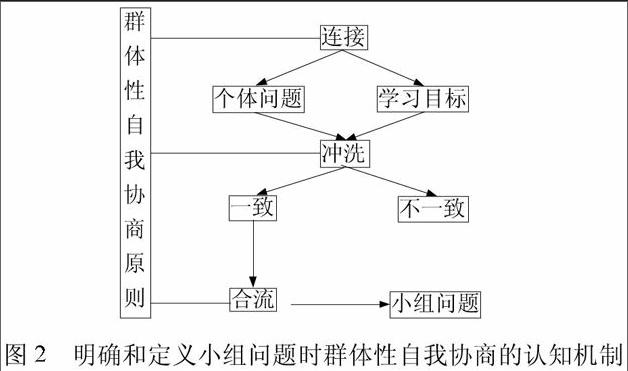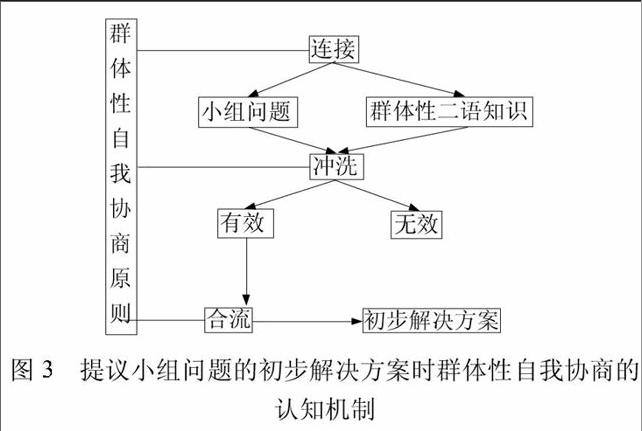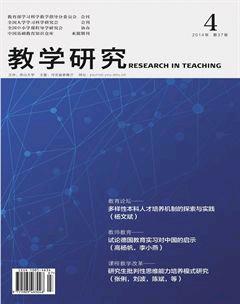自我協商、基于問題的二語學得:二語認知與建構的途徑
丁曉蔚



[摘 要] 基于問題的二語學得(Problem-based L2 Learning,PBLL)以發展二語認知和建構為主要目的之一,以目的語表述、結構不良的真實問題為二語學得起點,以自我協商原則引導和制約的群體合作和個體探究為二語認知途徑。PBLL自我協商過程的連接、沖洗和合流的認知機制不僅實現了定義問題、提議初步方案、自主探究證據、小組確定最終方案和小組匯報與反思諸個環節,而且貫穿整個PBLL,構成一個螺旋上升、動態生成的二語認知和建構過程。PBLL學習者的認知發展以自我一致、自我協調、自我核定、自我認同、自我滿足和自我允準為目的、手段和結果,從而使PBLL成為基于問題、自我協商的二語認知與建構的途徑。
[關鍵詞] 自我協商;基于問題;二語學得;認知機制
[中圖分類號] G642.4 [文獻標志碼] A [文章編號] 1005-4634(2014)04-0016-07
0 引言
基于問題的學習(Problem-based Learning,PBL)于誕生之初是一種課程模式,具有四大課程目標[1]:發展醫學院學生的臨床診斷能力、在不同情境中建構學科知識的能力、自主學習技能以及激發其學習興趣。后來,PBL從一門獨立課程發展成為教學策略[2],甚至成為教育的“完全途徑(Total Approach)”[3]。由于PBL具備建構主義、情境式、合作學習、自我監管以及學生主體等鮮明特性[4,5],很快就被不同學科所借鑒和應用,星火燎原般地從醫學擴展到科學、數學、工程技術[6]、心理學[7]、經濟與商學[8]及其它社會科學[9,10],以及語言教學[11],特別是外語教學[12]和二語習得領域。
因此,PBL的教育目標也得到補充和完善,包括激發學習者興趣與動機[13,14],幫助學習者建構和應用學科知識[15],促進主動參與和積極態度、培養自主學習者和終身學習者[14,16],發展解決問題的技能、社會交際與合作能力[16],增強其自尊和自我效能感[17],培養批判性思維[18,19]、認知和元認知能力[9,20]。
將PBL應用于二語習得(Second Language Acquisition,SLA)領域的“基于問題的二語學得(Problem-based L2 Learning,PBLL)”自然也不例外,其主要目標即幫助學習者建構豐富的二語“認知模式(Cognitive Models)”[21]。PBLL倡導二語學習者在解決問題的過程中進行情境式、建構式語言認知,以目的語表述、結構不良的真實問題作為二語學得的起點,以循環交替的導師輔導小組合作協商與個體自主探究為核心實施方法,通過理論建構[22]發展認知能力、生成學習者目的語知識。
然而,雖然西方學者已經判定PBL(因而包括PBLL)屬于信息加工或建構主義教育方法[9,23-26],實證研究表明了學習者的認知和元認知能力得到提高[9,20],而且國內學者也從思辨的角度論述了PBL在外語教學中的應用[12,27,28]及其實施困境[12],但現有文獻多從教育者視角進行剖析,卻忽略了從二語習得者視角的追問,更鮮有學者關注其二語建構的認知機制(Cognitive Mechanism):學習者進行社會協商和互動、認知和建構二語知識體系時的依據是什么?要回答這一問題,有必要從自我協商原則的視角審視PBLL過程。
1 自我協商原則
自我協商原則(Self-negotiation Principle)以哲學術語“主體自洽(Self-consistency)”為基礎,但后者強調意識平衡的結果,前者則突出認知平衡的過程。在PBLL視域中,自我協商原則指二語學習者嘗試理解和定義以目的語表述的真實情境中的問題、判斷和反思其解決方案時,達到“自我一致、自我協調、自我核定、自我認同、自我滿足和自我允準”[29]的程度。
由于PBLL采用了PBL的實施程序[25],即定義問題、提議初步方案、自主探究證據、小組確定最終方案和小組匯報與反思(包括“行動中反思(Reflection-in-action)”和“對于行動的反思(Reflection-on-action)”[30]),這意味著循環交替的個體自主探究和小組群體合作是PBLL的核心實施方法。因此,自我協商原則也相應細分為個體性和群體性自我協商原則。下文以一次案例研究所獲的質性數據為補充信息,闡釋和說明了PBLL自我協商過程:自我協商原則引導和制約了學習者“連接”、“沖洗”和“合流”的認知機制[29],不僅實現了PBLL各個環節,而且貫穿整個PBLL,構成一個螺旋上升、動態生成的二語認知和建構過程。
2 PBLL語言認知的自我協商過程
筆者在二年級非英語專業大學英語綜合課程中增加了PBLL環節,每個問題研究歷時2~4周。作為導師,還在任教班級中隨機選擇了一個PBLL小組(4男2女)進行輔導、觀察和記錄,并要求每個學生提交周記(做了什么、如何做、為何這么做)和總結。這些一手資料補充描述和解釋了PBLL語言認知的自我協商過程。
傳統的SLA教學往往是把二語體系的整體分解成子系統和分項,以語言形式或功能為語言學習的起點。但PBLL是以問題為起點的,因此具有鮮明的特點:(1)問題觸發二語學習,二語學習始終圍繞問題展開;(2)導師輔導小組合作為學習者提供中介(Mediation)平臺,輔助其社會建構和互動活動,因為語言是在社會互動中學得的;(3)充分的自主探究促進了學習者自主和賦權(Autonomy and Empowerment)[1,22,25,26,31]。
PBLL問題是用目的語表述的、在真實世界中觀察到的現象或事件,其中蘊含的目的語語言或文化知識可以用某種理論、原則或機制進行闡釋[32],從而激發和整合情境化的二語學習[33]。本次案例研究選取的問題是《Mr.Gibson's complaints》。
Mr. Gibson, our new foreign teacher, complains about the English translation of some signs on our campus.He has mentioned the sign "The grass is so fair.It needs your care" on the central lawn,which he finds "confusing"."That's the gardener's job",he said to our dean the other day,"A sign saying 'Please keep off the grass' works better".Other signs he complains about include "Water conservation is everyone's responsibility" above water taps,"Let's work together to reduce white pollution" on trash cans,and "It is everyone's responsibility to protect fire equipment" on fire hydrant boxes,which he feels "too long, wired,and empty".Please explain why Mr. Gibson feels like this,and what we should do.
2.1 定義問題的自我協商過程
PBLL的定義問題過程包括兩類自我協商:判斷個體問題時的個體性自我協商,以及定義小組問題時的群體性自我協商。
學生首次閱讀問題描述時,首先要嘗試內省地理解問題語境、判斷問題所在。有一名學生在周記中做了生動的敘述:
Mr. Gibson is "new" here. Maybe he is suffering from depression because he is all alone here and away from his family and friends back home.That's why he complains a lot.Maybe we should involve him more in our activities of English POP club to release his depression.But this seems more like a "problem" for learning in a social science class or psychology class.I then read the problem description again,and I noticed there must be something wrong with the English translation of those signs because they seem confusing and wired to native speakers like Mr. Gibson.This is the real point.But I don't see any grammatical mistakes in the translations.So it might be a problem of improper choice of wording, or maybe the expression is not "authentic" enough.
可見,問題引起了學生的好奇心。學生首先將問題情境中的新信息與個體的以往經驗和已有二語知識進行對比和聯系(連接),然后通過自我協調和自我核定,初步確定這二者之間的差距(Gap),這一過程可能包括一次或多次沖洗:如果個體認定某個新信息有意義,但無法同化到自己已有的二語知識體系中,就將其沖洗出來(正如從河灘的沙礫中淘出金子),構成差距或其中一部分。這種對差距的注意是一種認知資源[34],學習者借此集中腦力對問題進行判斷、核定和認可,直至實現自我滿足,從而使差距合流成自我允準的個體問題(參見圖1)。簡言之,PBLL學習者依據個體性自我協商原則詮釋和定義個體問題,從而完成認知過程的核心活動——內省的意義建構[35]。
判定各自的個體問題之后,PBLL學習者進行第一次導師輔導小組討論,進一步交流對問題的解釋、補充和求證。這本質上就是群體性意義協商的過程,因為在對問題情境中的關鍵信息達成共識之前先對個體問題進行集體討論有助于對關鍵信息的理解[20][23],促使小組特別注意選擇相關信息,篩除無關信息。個體問題是諸多備選項,供小組討論和選擇,最終確定一個小組問題。具體而言,PBLL小組首先連接個體問題與學習目標。如果這個群體性學習主體認定第一個問題問題與學習目標不符,或者遠遠超出小組當前的二語能力,或者當場由已掌握適當二語知識的組員闡釋解答,則對第一個問題問題的沖洗宣告失敗。小組繼而連接、沖洗其它個體問題,直到這一群體性學習主體滿意于討論結果,一致贊成、核準其小組問題,一致認定該問題符合學習目標,處于集體的“最近發展區(全稱為Zone of Proximal Development,縮寫為ZPD)”,從而激發了小組深入探究的欲望。這一群體性自我協商的過程正如導師的觀察記錄所描述:
They all agree that there must be a problem in the sign translation,which is "not authentic",or "not in the way English-speakers put it".But none of them see what is wrong with the translation,because after discussion,they find neither spelling mistakes nor grammar errors.To most of them,the English expression on the first sign is even more beautiful,poetic, and convincing than the one offered by Mr. Gibson.Then,they decide to compare the two versions, and one of them points out that our version is a "literal English translation from Chinese" rather than a "standard version".Some of them suggest that the "standard or native expression" of these signs should be collected and compared with our version,which will reveal what is wrong with the expression of our translation.The group prove this proposal.However, most of them are also interested in "why it is not proper",so they decide to include both "what" and "why" in their GP.
可見,達到自我滿足程度的群體性沖洗使合流成為可能,最終明晰、認可和定義了小組問題(參見圖2)。
2.2 提議初步解決方案的自我協商過程
小組問題的確定,隨即觸發了進一步的認知活動:嘗試性建模[22],即提議初步解決方案。
首先,PBLL學習者通過主體間協商(Inter-subjective Negotiation)交流和補充各自的已有二語知識,激發新的同化和順應,從而建構與小組問題相關的群體性二語知識。然后,PBLL小組連接小組問題和群體二語知識,從詞匯、句法、語用或文化等角度進行沖洗,從而判斷和核準后者對前者的有效性。兩者之間的空白就是解決小組問題所需但當前群體二語知識中欠缺的信息,這正是促生PBLL學習者新的語言認知的強勁動力。最后,所需信息合流成為初步解決方案,即當前PBLL的學習內容(參見圖3)。小組的群體性自我協商是通過組內協調、一致認同、集體核準,最終達到群體性主體自我滿足和允準的過程,如學生報告所述:
Three students mention possible cultural influence on the English translation of signs which are read by not only English-speakers,but also readers who understand English but not Chinese.Another student compares the 4 signs criticized by Mr. Gibson and assumes that there are different functions of signs:some inform people,some alert people,some just make an appeal,and so on.Two other students further assume that different functions of signs might also influence the way they are translated into English.Their hypotheses win applauses from the rest of us.At last, we decide to search for further information we need to answer the following sub-problems:
Sub-problem 1:What is the standard version of the last three signs that Mr. Gibson mentioned in English-speaking countries?
Sub-problem 2:Does the function of a certain sign influence the wording of its translation?
Sub-problem 3:Does the personal preference of translator influence sign translation?
Sub-problem 4:Does the cultural background of target readers influence the translation?
Sub-problem 5:Does it make sense that the so-called "standard" version is the optimal one?
Sub-problem 6:Is the so-called "standard" version culturally proper in local culture?
2.3 自主探究證據的自我協商過程
激活和建構群體二語知識有助于下一步的目的語自主認知。借助這一支架(Scaffold),PBLL學習者可以更清楚地注意到原本想當然但不準確甚或錯誤的個體二語知識,從而在自主探究證據環節中進行更有效的學習[32]。
這是學生第二次體驗個體性自我協商:每個組員負責解答一個子問題,并提供支持性證據(新信息)。下文所示的學生周記描述了這一環節的典型過程:
The sub-problem assigned to me is "Does the function of a certain sign influence the wording of its translation?" I searched in the library for 2 hours but was still quite at a loss.Then I figured out that it might be more efficient and fruitful to search in digital databases of the library.First I typed in "function of sign" as key words,but popped-out searching result list was way too long.I had to research in the result by adding one more key word "translation" to produce a shorter list.I also noticed that the articles with higher correlation with the key words were ranked in the first couple of webpages.I briefly read through their abstracts before I selected and downloaded some review articles about Text Typology theory that seem most useful to me.From these articles,I learned that a German scholar named Reiss categorized texts into informative, expressive and operative ones with their respective function of delivering information, arousing certain emotion,and persuading readers into taking specific actions.I suddenly understood why Mr. Gibson felt wired when seeing our sign on the lawn. That sign should serve a function of persuading readers into protect the grass by "keeping off the grass", rather than an expressive translation that only gets readers emotionally attached.The rest sign translations Mr. Gibson complained about are also expressive only,without any operative function. In order to justify my solution,I went ahead to read more articles authored by Chinese scholars on regarding to sign translation,as well as some empirical research reports with convincing data.Now I believe I'm well prepared for the next tutorial group meeting.
可見,學生個體首先要自主選擇和判斷收集新信息的渠道、方式和資源,然后連接證據和子問題。如果該學生依據自己的已有二語知識對二者進行沖洗并自我判定前者不足以解釋后者時,就要進行新一輪自主探究、收集新證據、再次連接和沖洗,直至學生個體認定核實證據有效性,且自我滿足地允準合流成子問題的解決方案(新的個體二語知識)。換言之,PBLL賦權學生決定自主學習內容,個體性自我協商原則引導學生進行自主探究和內化,培養了有內部學習動機的自主學習者[13,14]。這一建構個人構念[36]的過程如圖4所示。
2.4 確定最終方案的自我協商過程
完成自主探究后,PBLL小組再次集中討論,檢驗是否深入理解了小組問題[32]。學生匯報所學內容,補充、分析所獲證據,把有效的子問題解決方案整合成小組問題的最終方案。前者就像拼圖小片,后者是最終所拼圖案。在這拼圖游戲過程中,群體性學習主體把小組問題與每個子問題方案逐一進行連接,以便沖洗出恰當的拼圖小片及其在整個圖案中的位置。如果小組一致認定和核準某些子問題解決方案足以證實或支持最初提議的方案,則可作為充分有效證據合流到最終方案(二語新知識)中,用以清楚闡釋或充分解決小組問題(參見圖5)。
可見,新證據用以檢驗最初方案,但另一方面,最初方案也經常因新證據而得到豐富和修正。如果小組辯論后一致判定新證據不足以證實某個子問題解決方案,就需要進行新一輪自主探究,收集更多新信息;或者新證據為小組提供了新的解決思路,則必須調整最初方案,以便順應新的方案。這種螺旋上升的認知過程往往啟迪學習者超越原本學習目標甚或課程大綱,培養了其批判性思維和創造性。以下觀察記錄可以佐證。
The student responsible for sub-problem 1 reports to the group the "standard translation" of the last 3 signs:"Make the Most of Every Drop","Recycle,reuse;every little bit helps" and "Fire Hydrant Keep Clear".However,4 of the students question the "authority" of "Standard English",because English has become a Lingo Franca as a universal working tool,not an exclusive criterion anymore.They argue that different variations of English around the world are appreciated and accepted nowadays.Similarly, the 2 students in charge of culture-related sub-problems report to the group that the target language culture should not be superior to the local one,either, and the latter should also be taken into consideration by translators.Therefore,they put forward a further question:"Isn't it one of the purposes for foreign visitors to experience the local culture?"The group finds it reasonable that the literal translation of signs from Chinese into English is an authentic material for foreig ners to understand the collective culture of China, one of whose features is to call for all members of community to take responsibility and work together for a common goal.They also suggest that it is "culturally necessary" for foreigners to appreciate the Chinese way of using metaphors.For example,the word "care" metaphorizes the lawn into something beautiful but fragile like a newborn baby,therefore arouses stronger affection of readers,and provides them with a rationale of protecting it by "keeping off the grass" or "no littering",etc.One of the students even brings forward a suggestion to foreign visitors:"If they would like a fruitful stay in China and successful communication with Chinese people,they should develop their cross-cultural '3rd space' by integrating their personal knowledge of native culture and the local one!" The "burst" of creative ideas based on available evidence seems to be the part they enjoy a lot.
2.5 匯報與反思的自我協商過程
PBLL小組用目的語向全班報告小組結論(即所學得的新二語知識),并進行充分的評價和反思。他們把PBLL過程中的認知體驗與小組結論連接起來,通過群體性判斷和核準進行沖洗,即總結收獲和感悟,反省教訓和彎路。當小組取得共識,達到群體性自我認同和滿足時,就實現了合流,生成有效學習策略、解決問題策略、監控自己語言認知的元認知策略,以便促進和指導未來遇到的相似情境的PBLL學習(參見圖6)。
參與案例研究的學生在總結中提到,“理論建構”過程(特別是定義問題、自主探究和小組協商最終方案時)促生了更多的認知策略。學生還肯定了PBLL的認知性活動(如意義協商、概念化、合作、整合與關聯等)發展了其概念理解能力和認知策略,使他們“理解得更透、知識面更廣、洞察得更深”。學生還在總結中報告了多種元認知策略,如根據PBLL安排、可支配時間和小組目標設定學習內容,提前制定計劃,自我約束、自我監控和適時調整小組合作與自主探究。學生把這些策略看作促進自信和自我效能感的關鍵因素,因為他們“學會了如何學習”。這些發現印證了PBL培養學習者認知與元認知能力的實證研究結論[9,20]。
3 結束語
如前所述,PBLL的核心特征就是自我協商:學習者不斷內省地與個體自己協商,不斷與其他組員相互協商,以自我一致、自我協調、自我核定、自我認同、自我滿足和自我允準為目的、手段和結果。導師輔導小組作為一個群體性學習主體,以群體性自我協商的形式支持和促進了學習者認知和元認知的發展[33];在自主探究和個體意義建構中,PBLL個體學習者重新塑造、調整和順應個體已有二語知識體系,本質上是個體性自我協商的過程。
自我協商的PBLL是動態發展、互動生成的,因為在每個環節中,學習者都要經歷一次或多次連接和沖洗,直到合流成功,并進一步觸發隨后環節的語言認知。這樣,PBLL每個環節中認知機制的小循環最終構成了整個PBLL認知機制的大循環。如圖7[37]所示,個體性與群體性自我協商交替循環,使得問題動態發展,個體學習者、其他組員與目的語表述的情境化問題之間發生持續互動,生成了新的二語知識、認知策略以及其他應用能力。
概言之,PBLL促使二語學習者進行自我協商的二語建構,“充分施展才能,全神貫注于問題,因而發現了充分有效學習的樂趣”[38]。自我協商原則引導和制約著連接、沖洗和合流,即PBLL學習者的認知機制,在整個PBLL認知過程中起著不可或缺的作用。貫穿PBLL全部過程的“問題”和學習者的自我協商活動,使PBLL成為基于問題、自我協商的二語認知與建構的途徑。
參考文獻
[1]BARROWS H S.How to design a problem-based curriculum for the preclinical years[M].New York:Springer,1985.
[2]WOODS D.Problem-Based Learning:How to Gain the Most from PBL[M].Waterdown,Canada:Woods,1994.
[3]BARROWS H S,TAMBLYN R M.Problem-based learning[M]. New York:Springer,1980.
[4] BROWN J S,COLLINS A,DUGUID P.Situated cognition and the culture of learning[J].Educational Researcher,1989,18(1): 32-42.
[5]SCARDAMALIA M,BEREITER C.Higher levels of agency for children in knowledge building:A challenge for the design of new knowledge media[J].Journal of the Learning Sciences,1991,(1):37-68.
[6]SPRINGER L,STANNE M E,DONOVAN S S.Effects of small group learning on undergraduates in science,mathematics,engineering, and technology: Ameta-analysis [J]. Review of Educational Research,1999,69(1):21-51.
[7]REYNOLDS F.Studying psychology at degree level:Would problem-based learning enhance students' experiences[J].Studies in Higher Education,1997,(22):263-275.
[8]GIJSELAERS W H,TEMPELAAR D T,KEIZER P K,et al. Educational innovation in economics and business education:The case of problem-based learning[M].Dordrecht,Netherlands: Kluwer Academic,1995.
[9]SAVERY J R,DUFFY T M.Problem-based Learning:An instructional model and its constructivist framework [J]. Educational Technology,1995,(35):31-38.
[10]BRIDGES E M,HALLINGER P.Problem-based learning in leadership education [M]// WILKERDON L,Gijseiaers W H. Bringing problem-based learning to higher education:Theory and practice.San Francisco:Jossey-Bass,1996:53-61.
[11]ERIC Development Team.Problem-Based Learning in language instruction:A constructivist model,ED423550[R].Eric Digest, 1998.
[12]支永碧.PBL在中國外語教育中的應用——意義、困境與出路[J].外語與外語教學,2009(7):33-37.
[13]BARROWS H S.Problem-based learning in medicine and beyond: A brief overview[M]// WILKERSON L,GIJSELAERS W H. Bringing problem-based learning to higher education: Theory and practice.San Francisco:Jossey-Bass,1996:3-12.
[14]STOKES S,MACKINNON M,WHITEHILL T.Students' Experiences of PBL: Journal and Questionnaire Analysis [J]. Journal of University Didactics,1997,21(1):161-179.
[15]VERNON D T A,BLAKE R L.Does problem-based learning work-A meta-analysis of evaluative research [J]. Academic Medicine,1993,(68):550-563.
[16]MICHAELSEN LK,BLACK RH.Building learning teams:The key to harnessing the power of small groups in higher education [M]// KADEL S,KEEHNER J.Collaborative learning:A sourcebook for higher education(Vol.2). State College,PA:National Center for Teaching,Learning,and Assessment,1994:65-81.
[17]AMES C.Classrooms: Goals, Structures, and Student Motivation [J].Journal of Educational Psychology,1992,84(3):261-271.
[18]BOUD D,FELETTI G I.Changing problem-based learning.Introduction to the second edition [M]// BOUD D, FELETTI G I. The challenge of problem-based learning(2nd ed.).London: Kogan Page,1997:1-14.
[19]TIWARI A,LAI P,SO M,et al.A comparison of the effects of problem-based learning and lecturing on the development of students' critical thinking[J]. Medical Education, 2006, (40): 547-554.
[20]DE GRAVE W S, SCHMIDT H G, BOSHUIZEN H P A.Effects of problem-based discussion on studying a subsequent text:A randomized trial among first year medical students [J].Instructional Science,2001,(29):33-44.
[21]DOLMANS D,SCHMIDT H G.What directs self-directed learning in a problem based curriculum[M]// EVENSEN D, HMELO C.Problem Based Learning:A research perspective on learning interactions.Mahwah,NJ:Lawrence Erlbaum,2000: 251-262.
[22]SCHMIDT H G.Problem-based learning:Rationale and description [J].Medical Education,1983,17(1):11-16.
[23]SCHMIDT H G,DE GRAVE W S,DE VOLDER M L,et al. Explanatory models in the processing of science text:The role of prior knowledge activation through small-group discussion[J]. Journal of Educational Psychology,1989,(81):610-619.
[24]NORMAN G R,SCHMIDT H G.The psychological basis of problem-based learning:A review of the evidence [J].Academic Medicine,1992,(67):557-565.
[25]SCHMIDT H G.Foundations of problem-based learning-Some explanatory notes [J]. Medical Education,1993,(27):422-432.
[26]HMELO-SILVER C E.Problem-based learning:What and how do students learn[J].Educational Psychology Review, 2004,(16):235-266.
[27]孫志農,仇旭.論問題式學習在外語教學中的應用[J].安徽農業大學學報,2009(6):115-118.
[28]喬玉玲,郭麗萍.PBL教學法在大學英語閱讀教學中的應用[J]. 教育理論與實踐,2011(10):58-60.
[29]王文斌.隱喻的認知構建與解讀[M].上海:上海外語教育出版社, 2007.
[30]SCHON D A.The reflective practitioner:How professionals think in action[M].New York:Basic Books,1983.
[31]EVENSEN D H,HMELO C E.Problem-based learning:A research perspective on learning interactions[M].Mahwah,NJ: Lawrence Erlbaum,2000.
[32]SCHMIDT H G.Assumptions underlying self-directed learning may be false [J].Medical Education,2009,(34):243-245.
[33]NEWMAN M.Problem Based Learning:An introduction and overview of the key features of the approach[J].Journal of Veterinary,2005,32(1):12-20.
[34]BEST J B.Cognitive psychology[M].St.Paul, MN:West,1986.
[35]AUSUBEL D.Educational psychology:A cognitive view[M]. New York:Holt,Rinehart and Winston,1968.
[36]KELLY G.The psychology of personal constructs[M].New York:Norton,1955.
[37]王文斌.隱喻的認知建構與解讀[M].上海:上海外語教育出版社,2007 :116.
[38]WILLIAMS M,BURDEN R L.Psychology for Language Teachers[M].Beijing:Foreign Language Teaching and Research Press,2000:25.

